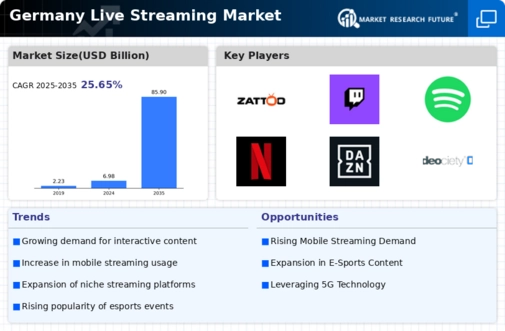Growth of Mobile Streaming
The proliferation of smartphones and mobile internet access is significantly impacting the live streaming market in Germany. With over 80% of the population owning smartphones, mobile streaming has become a primary mode of content consumption. This shift is evidenced by a 40% increase in mobile viewership over the past year. The live streaming market is witnessing a transformation as content creators optimize their streams for mobile devices, ensuring seamless viewing experiences. Additionally, mobile platforms are increasingly incorporating features that cater to on-the-go users, such as offline viewing and adaptive streaming quality. This trend not only broadens the audience base but also enhances monetization opportunities through targeted advertising and subscription models.
Expansion of Localized Content
The live streaming market in Germany is experiencing a significant expansion in localized content offerings. As audiences increasingly seek content that resonates with their cultural and linguistic backgrounds, platforms are responding by curating and promoting local creators. This trend is reflected in a 35% increase in viewership for localized streams over the past year. The live streaming market is thus becoming more inclusive, catering to diverse demographics and preferences. By focusing on localized content, platforms can foster community engagement and attract advertisers looking to reach specific audiences. This strategy not only enhances viewer satisfaction but also positions platforms as leaders in the competitive landscape, as they prioritize content that reflects the interests and values of local audiences.
Integration of Advanced Analytics
The live streaming market in Germany is increasingly leveraging advanced analytics to enhance content delivery and viewer engagement. By utilizing data analytics, platforms can gain insights into viewer preferences, peak viewing times, and engagement patterns. This information is crucial for content creators and brands aiming to optimize their strategies. Recent studies indicate that platforms employing data-driven approaches have seen a 20% increase in viewer retention rates. The live streaming market is thus evolving into a more data-centric environment, where decisions are informed by real-time analytics. This trend not only improves content relevance but also enhances advertising effectiveness, as brands can target their campaigns more accurately based on viewer behavior.
Emergence of Subscription-Based Models
The live streaming market in Germany is witnessing a shift towards subscription-based revenue models. As consumers become more accustomed to paying for premium content, platforms are adapting by offering exclusive live streams and content for subscribers. Recent data indicates that subscription revenues in the live streaming market have increased by 25% in the last year. This model not only provides a steady revenue stream for content creators but also enhances viewer loyalty, as subscribers are more likely to engage with exclusive content. Furthermore, platforms are exploring tiered subscription options, allowing users to choose packages that best fit their viewing preferences. This trend suggests a potential for sustained growth in the live streaming market as more users opt for premium experiences.
Rising Demand for Real-Time Engagement
The live streaming market in Germany experiences a notable surge in demand for real-time engagement features. As audiences increasingly seek interactive experiences, platforms that facilitate live chats, polls, and Q&A sessions are gaining traction. This trend is reflected in a 30% increase in user engagement metrics across various platforms. The live streaming market is adapting to these preferences by integrating advanced technologies that enhance viewer participation. Furthermore, brands are leveraging these features to foster community building and brand loyalty, which is essential in a competitive landscape. The ability to connect with audiences in real-time not only boosts viewer retention but also drives advertising revenues, as brands are willing to invest more in platforms that offer interactive capabilities.
























Leave a Comment